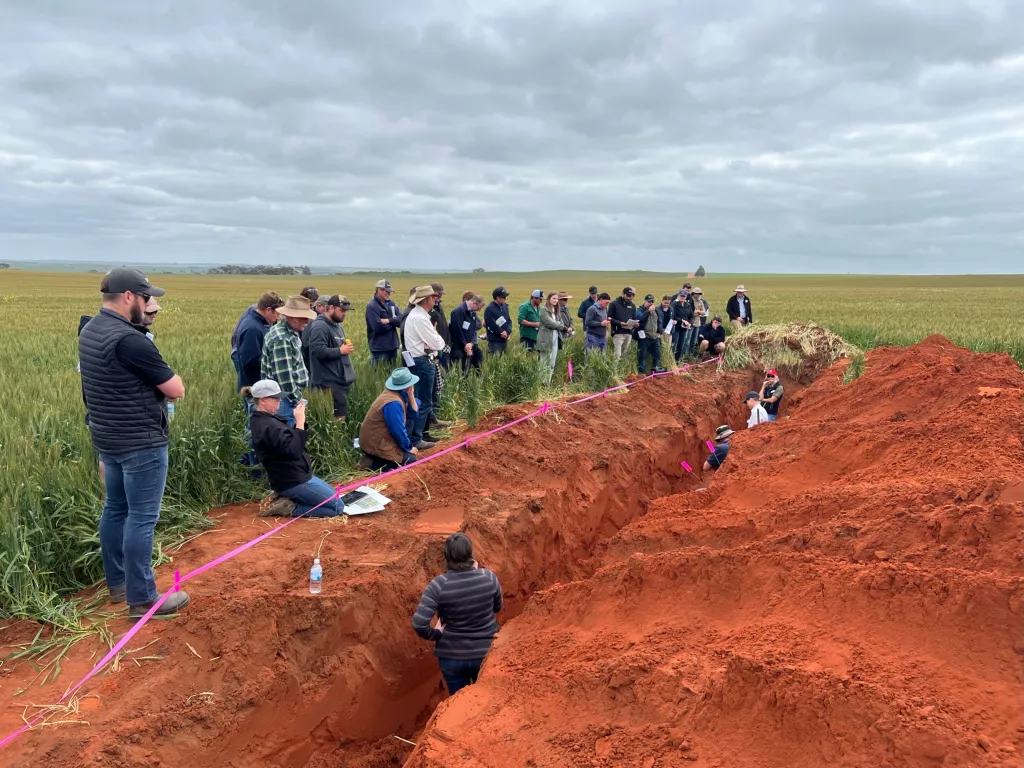Soil amelioration & water repellence: Investigating the next generation of strategies
By Kate Parker & Simon Kruger, WMG Projects Team
Farmers across the Northern Ag region of WA are faced with the significant, ongoing challenge of managing soil water repellence. The regions sandy soils are low in clay content and as a result, have a low surface area. Waxy substances that originate from plant organic matter when they decompose are left in the soil to coat sand particles and over time this process causes the soil to have reduced infiltration of rainfall. This leads to patchy crop emergence and lowers grain yield whilst also causing issues with weed management and fertiliser use efficiency. Farmers across the region have successfully implemented a range of soil amelioration strategies for deep sandy soils where there are few physical obstructions to the use of deep tillage equipment like mouldboard ploughs, rotary spaders, and deep rippers; often leading to a consistent increase in grain yield and increased profitability.
While this approach has been successful on the deep sandy soils, farmers are seeking more information on tackling some of the other soil types in the region. Many growers experience the presence of multiple soil types in one paddock; from rock to gravel to coloured and white sand. Each soil type has its challenges with differing responses to applying the same soil amelioration practices inclusive of different returns on investment. Unfortunately, there is not a ‘one size fits all’ approach in paddocks where there are many soil types, with farmers requiring the skills to identify the soil constraints in their paddock, understand which practice is likely to be effective in each soil type, and gain confidence to apply this knowledge and implement the practices across their farm.
The West Midlands Group (WMG) have been working in the area of soil amelioration for nearly 15 years, having first starting helping farmers address soil water repellency in the region after 2009. Our current focus in soil amelioration is on developing the next generation of strategies that build on the first generation of soil amelioration to improve long-term soil health. This is primarily in the field of stacking soil amendments and amelioration strategies, identifying soil amelioration options for paddocks with variable soil types, and in tackling the issue of re-emergence and/or prevention of re-emergence of soil water repellence in the region.
The GRDC funded Soil Amelioration Project aims to explore key aspects of soil amelioration on variable soil types including:
- Diagnosing paddock scale soil constraints.
- Identifying the most appropriate amelioration method(s) for the constraints.
- Determining the economic advantage (ROI for the paddock) behind these methods.
Over the next three years, WMG will establish a network of Participatory Action Research (PAR) groups and demonstration sites across the Geraldton and Kwinana West port zones. Each year, 1-2 sites will be established with local PAR groups that build on the learnings from previous years to increase and develop the farmer knowledge base on successful soil amelioration strategies.
This years first site, located on the Creagh’s property in Dandaragan, is looking at amelioration methods on a gravel soil type with non-wetting issues. The site was ameliorated at the beginning of June with the following 4 methods:
- Plozza Plow
- Fanger Plow (Deep rip)
- Nufab Rip/Delve
- Nufab Rip/Delve – Double pass






Sown to oats in the week following amelioration, the site will now be monitored throughout the growing season to assess each treatment. There will be a crop walk at the site in the coming weeks for growers to have a good look across the trial, with more details to follow. In the meantime, enjoy this short clip of some of the amelioration tools in action and be sure to join an amelioration discussion group via the link below!













